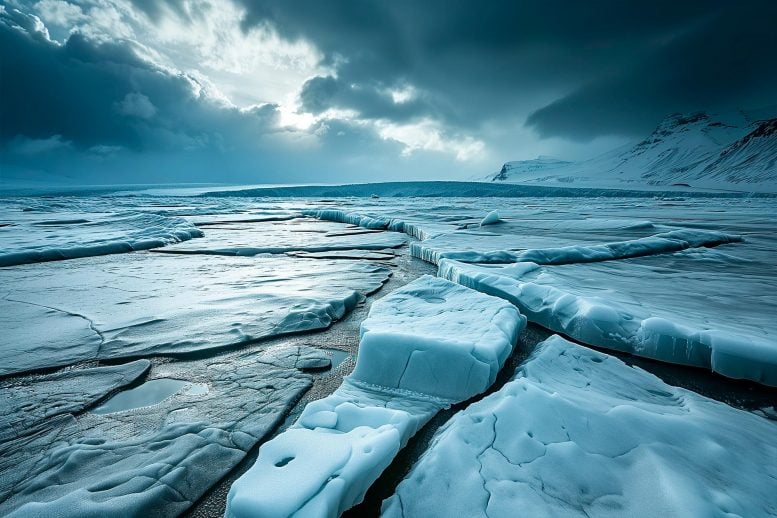New Study Reveals Promising Solution against Ice Sheet Loss due to Climate Change: Stratospheric Aerosol Injection

A recent research suggests that utilizing stratospheric aerosol injection (SAI) could potentially curtail ice sheet melting, a direct effect of climate change. On the other hand, the method draws criticism as it tends to tackle the manifestations of global warming rather than the underlying root causes, besides its unpredictable impacts on organic systems. Source: SciTechDaily.com
A series of simulations point out the possibility of slowing down the ice sheet melting caused due to global warming by injecting aerosols in the stratosphere.
Global warming leads to a myriad of effects, one of which includes the rise in sea-level owing to the melting and retreat of the Earth’s ice sheets and glaciers, along with other sources. This rise in sea level can potentially render large patches of densely populated coastal land uninhabitable unless significant coastal modifications are carried out. Therefore, to prevent this scenario, carbon emissions need to achieve a net negative status, a feat difficult to materialize under present conditions.
Simulated outcomes of the Greenland ice sheet mass loss from 1990 to 2090, as portrayed as a contribution to sea-level under different circumstances: RCP8.5 (red; worst-case scenario, unabated warming), RCP4.5 (green; intermediate scenario, potentially achievable under current conditions), and GeoMIP G4 (blue; RCP4.5 together with the injection of 5 million metric tons of sulfur dioxide each year into the stratosphere during 2020–2070). Source: Ralf Greve
There is an array of proposals to harshly reduce the consequences of climate change, with the most extensive ones suggesting interventions that would remodel aspects of the entire globe—these are referred to as the geoengineering techniques. However, they show some potential, understanding about natural cycles is not comprehensive enough to fully gauge how beneficial these interventions would be.
Research conducted by an international team, spearheaded by Professor John C. Moore at the University of Lapland, Rovaniemi, Finland, and Professor Ralf Greve, at the Institute of Low-Temperature Sciences, Hokkaido University, employed simulations to analyze the probable effects of the geoengineering technique known as stratospheric aerosol injection on ice sheet melting. Their discoveries were published in the Journal of Geophysical Research: Earth Surface.
Ralf Greve (left) and John C. Moore (right), who authored the study. Source: Ralf Greve, John Moore
Moore describes that stratospheric aerosol injection (SAI), would manually introduce aerosols into the stratosphere using aircraft or high-altitude balloons to establish a cooling effect, achieved through global dimming and increased albedo—the measure of Earth’s sunlight reflection.
Moore, Greve, and their team used the SICOPOLIS model to recreate the alterations in the Greenland Ice Sheet during the period 1990–2090 under three differing scenarios including RCP8.5 (worst-case scenario, unabated warming); RCP4.5 (intermediate scenario, possibly achievable under current conditions); and GeoMIP G4 (RCP4.5 with the additional inclusion of 5 million metric tons of sulfur dioxide each year into the stratosphere during 2020–2070).
As per the SICOPOLIS simulations results comparing the transformation of the Greenland Ice Sheet between GeoMIP G4 and RCP4.5: ice thickness (H). The stratospheric aerosol injection of sulfur dioxide would have the most protective effect on the peripheries (which remain thicker; yellow and red) of the ice sheet. This is sourced from the article written by John C. Moore, Ralf Greve and others for the Journal of Geophysical Research: Earth Surface. Published on November 27, 2023
The simulations revealed a noticeable protective effect of sulfur dioxide's SAI on the Greenland Ice Sheet. Under RCP8.5, the equivalent ice loss would be around 90mm sea-level rise; under RCP4.5, this ice loss would be approximately 60.6mm sea-level rise; but under GeoMIP G4, the ice loss would be barely about 37.6mm sea-level rise. When the same scenarios were subjected to a different model, Elmer/Ice, the outcomes were alike. The ice sheet's margins would obtain maximum benefits under GeoMIP G4.
Although this study suggests that SAI could aid in preserving the Greenland Ice Sheet and possibly all the other ice covers on Earth, geoengineering as a topic is highly arguable,” concludes Greve. According to him, the biggest problem is that it deals only with the symptoms of global warming and not the primary causes which may even lead to delays in making necessary changes. Further, predicting both positive and negative outcomes accurately is impossible due to the massive complexity of natural systems on Earth.
Reference: "Reduced Ice Loss From Greenland Under Stratospheric Aerosol Injection" by John C. Moore, Ralf Greve, Chao Yue, Thomas Zwinger, Fabien Gillet-Chaulet, and Liyun Zhao, published on November 27, 2023, in Journal of Geophysical Research Earth Surface.
The study was funded by the National Key Research and Development Program of China, the State Key Laboratory of Earth Surface Processes and Resource Ecology, the Finnish Academy COLD consortium, the Japan Society for the Promotion of Science, the Ministry of Education, Culture, Sports, Science and Technology of Japan, and Hokkaido University.




